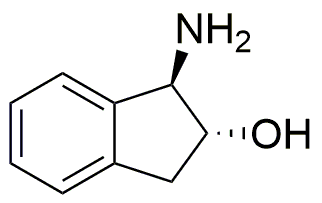(1R,2R)-(-)-1-Amino-2-indanol is widely utilized in research focused on:
- Pharmaceutical Development: This compound serves as a crucial intermediate in the synthesis of various pharmaceuticals, particularly in the development of drugs targeting neurological disorders.
- Chiral Catalysis: Its unique chiral properties make it valuable in asymmetric synthesis, allowing chemists to create enantiomerically pure compounds, which are essential in drug formulation.
- Biochemical Research: Researchers use it to study enzyme interactions and protein folding, helping to understand biological processes and disease mechanisms.
- Material Science: The compound is explored for its potential in creating innovative materials with specific optical or electronic properties, beneficial for developing advanced technologies.
- Analytical Chemistry: It is employed as a standard in various analytical techniques, aiding in the accurate quantification and characterization of related compounds in complex mixtures.
Informations générales
Propriétés
Sécurité et réglementation
Applications
(1R,2R)-(-)-1-Amino-2-indanol is widely utilized in research focused on:
- Pharmaceutical Development: This compound serves as a crucial intermediate in the synthesis of various pharmaceuticals, particularly in the development of drugs targeting neurological disorders.
- Chiral Catalysis: Its unique chiral properties make it valuable in asymmetric synthesis, allowing chemists to create enantiomerically pure compounds, which are essential in drug formulation.
- Biochemical Research: Researchers use it to study enzyme interactions and protein folding, helping to understand biological processes and disease mechanisms.
- Material Science: The compound is explored for its potential in creating innovative materials with specific optical or electronic properties, beneficial for developing advanced technologies.
- Analytical Chemistry: It is employed as a standard in various analytical techniques, aiding in the accurate quantification and characterization of related compounds in complex mixtures.
Documents
Fiches de données de sécurité (FDS)
La FDS fournit des informations de sécurité complètes sur la manipulation, le stockage et l’élimination du produit.
Spécifications du produit (PS)
Le PS fournit une description complète des propriétés du produit, notamment sa composition chimique, son état physique, sa pureté et les exigences de stockage. Il détaille également les plages de qualité acceptables et les applications prévues du produit.
Certificats d'analyse (COA)
Recherchez des certificats d'analyse (COA) en saisissant le numéro de lot du produit. Les numéros de lot et de lot se trouvent sur l'étiquette d'un produit, après les mots « Lot » ou « Lot de fabrication ».
Numéro de catalogue
Numéro de lot/série
Certificats d'origine (COO)
Ce certificat d'exploitation confirme le pays dans lequel le produit a été fabriqué, et détaille également les matériaux et composants utilisés et s'il est issu de sources naturelles, synthétiques ou autres sources spécifiques. Ce certificat peut être requis pour les douanes, le commerce et la conformité réglementaire.
Numéro de catalogue
Numéro de lot/série
Fiches de données de sécurité (FDS)
La FDS fournit des informations de sécurité complètes sur la manipulation, le stockage et l’élimination du produit.
DownloadSpécifications du produit (PS)
Le PS fournit une description complète des propriétés du produit, notamment sa composition chimique, son état physique, sa pureté et les exigences de stockage. Il détaille également les plages de qualité acceptables et les applications prévues du produit.
DownloadCertificats d'analyse (COA)
Recherchez des certificats d'analyse (COA) en saisissant le numéro de lot du produit. Les numéros de lot et de lot se trouvent sur l'étiquette d'un produit, après les mots « Lot » ou « Lot de fabrication ».
Numéro de catalogue
Numéro de lot/série
Certificats d'origine (COO)
Ce certificat d'exploitation confirme le pays dans lequel le produit a été fabriqué, et détaille également les matériaux et composants utilisés et s'il est issu de sources naturelles, synthétiques ou autres sources spécifiques. Ce certificat peut être requis pour les douanes, le commerce et la conformité réglementaire.


